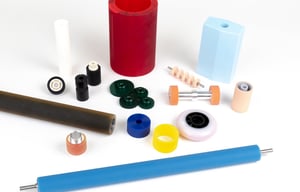Polypropylene vs. Polyurethane: Which Material is Right for Your Design?
While polypropylene and polyurethanes may look and feel the same, both offer distinct advantages depending on your design needs. Understanding their key differences can help you make the right choice for your product.
Need help deciding? Start with our design tool or download our datasheets to learn how our advanced thermoset polyurethane solutions can meet your exact specifications.
What is Polypropylene?
Polypropylene (PP) is created through the polymerization of propylene gas. As a thermoplastic, polypropylene can easily take shape through processes like injection molding or thermoforming, particularly when heated. This flexibility allows polypropylene to display a wide range of properties based on the chosen manufacturing method. While polypropylene shares similarities with polyethylene, polyurethanes typically offer more robust physical properties, especially in extreme environments.
 What is Polyurethane?
What is Polyurethane?
Unlike polypropylene, polyurethane is a thermoset formed through the chemical reaction between a polyol and diisocyanate. Despite having a complex chemical structure, this unique material can allow engineers to tailor its chemistry to meet specific design requirements. For example, polyurethanes can be custom formulated to be either soft and flexible or hard and rigid. Their adaptability provides unlimited design freedom through a cast molding processes.
Differences Between Polypropylene & Polyurethane
Despite having similar names, polyethylene and polyurethanes differ significantly. The table below highlights key distinctions between these materials:
| Polypropylene | Polyurethane |
| Commonly injection molded or thermoformed | Commonly cast molded |
| Limited durometers available | Can be custom formulated to meet exact design needs |
| Low resistance to heat | Able to withstand temperatures between -80°F up to 300°F |
| Difficult to bond | Can bond to various subcomponents |
| Can be made conductive through the use of carbon black | Can be made conductive without the use of carbon black |
Which Material Should You Choose?
Choosing between polypropylene and polyurethane depends on your product design requirements. Polyurethanes generally can produce stronger, more robust products that withstand harsh environmental conditions, making them ideal for applications in military & defense, industrial, medical, and packaging sectors to name a few. Polypropylene, on the other hand, is often suitable for products that do not require longevity or wear resistance, commonly found in consumer goods and packaging.
Conclusion
While polypropylene may be appropriate for short term applications, polyurethane excels in demanding environments where durability is crucial. When evaluating your material options, understanding these differences can significantly impact your product's success.
If you're ready to evaluate your design with the right material, complete our design tool, or download our datasheets to discover the superior properties of our advanced polyurethane solutions.





